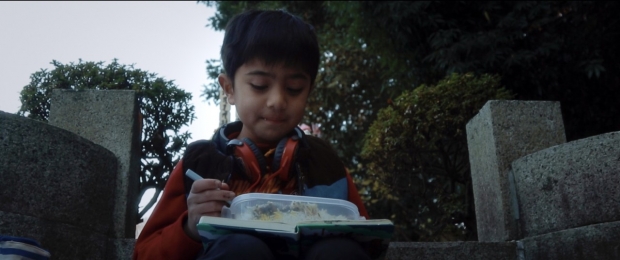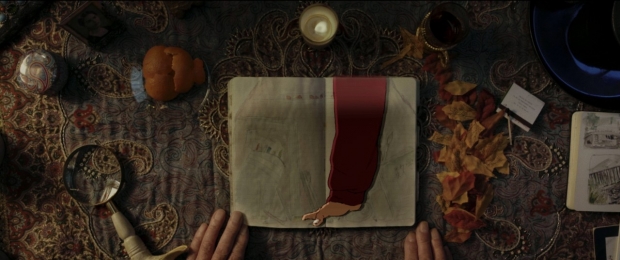The first-generation Iranian-American filmmaker, who for years denied his heritage, fell in love with his culture again while on an NYU exchange program in Japan as he spent time in Tokyo graveyards and began developing the story of a displaced Iranian boy.
Liam LoPinto spent most of his childhood denying his Iranian heritage. A first-generation Iranian-American, LoPinto says he would regularly tell his mother not to pick him up from school, or attend parent-teacher conferences, out of fear that people would ask where his family came from. But, in 2016, the then-aspiring filmmaker found himself in Japan as part of an NYU exchange program and, among the graveyards of Tokyo, began to fall in love with his culture again as the story of a young Iranian boy displaced to Japan started taking form in his mind.
“There are plenty of stories that I’ll articulate later into films about my own family and its experience in the U.S., and even my own experience in my extended family, being refugees and being in Europe or abroad and things like that,” notes LoPinto. “But this film was about me reclaiming my own culture. And apologizing to my mom.”
The Old Young Crow, which recently screened at this year’s SCAD Savannah Film Festival and is making the rounds at other festivals over the next two months, is an award-winning live-action/animation hybrid short film about an Iranian child named Mehrdad (Naoto Shibata) who moves to Japan with his father after the death of his mother.
The film – which will screen at the Anchorage International Film Festival and Miami Short Film Festival on Sunday, November 19 – begins with a senior-aged Mehradad pulling out his old sketchbook and narrating a fantastical tale about the time his younger self was visited by a crow in a graveyard and a woman named Chiyo (Keiko Yamashita), who had lost her son and gifts him with her son’s old sketch pen. Through a series of beautiful animated and live-action sequences that bring Mehradad’s childhood sketches to life, the boy learns to accept his identity as an Iranian and Japanese citizen and face the grief of losing his mother.
The senior Mehradad’s hand movements through the sketchbook and narration are courtesy of LoPinto’s own 96-year-old Iranian grandfather, Hassan Shahbazi, who is convinced that the entirely fictitious Chiyo is a real person his grandson met during his time in Tokyo.
“He always asks me how Chiyo is doing and tells me to tell her hi the next time I go to Japan,” says LoPinto. “It’s cute.”
Shahbazi isn’t the only one who’s taken the film’s story fully to heart, as The Old Young Crow – now qualified for this year’s Academy Awards’ Best Live-Action Short – has been mistakenly put in a number of documentary categories during its festival run. But perhaps that’s just a testament to LoPinto’s storytelling, which not only contains much of his own emotional journey, but draws on family LoPinto’s father, two uncles, and aunt all assisting with some of Shahbazi’s scenes filmed in LoPinto’s sister’s room. LoPinto also recruited his friends from Cal Arts to assist with the film’s hand-drawn animation.
“Mehrdad’s sketchbook is the home of all the film’s animation,” explains LoPinto. “And that whole sequence in the beginning, that articulates Tokyo in the sketchbook, had to feel like you're in a child's perspective. But you also have to feel a swarm of a city, which is why a lot of the angles are either from a bird's-eye view, or a dramatic bug's-eye view. It's that kind of weird perspective that you would get from being a child foreigner in a new country. Everything feels either really big or alien in a certain way.”
The tactility that comes with a child’s aggressive and unfiltered sketches also had to come through in the animation, some of which is more refined in the film, while other animated sequences are more broken and rough.
“If you want to create something that feels organic and like a real sketchbook with the same texture, then the majority of the animation needs to be hand-drawn on paper,” says LoPinto. “I got a lot of blisters. And thankfully, I wasn’t doing it alone.”
Though LoPinto was assisted in the animation by over half a dozen animator friends, he created the film’s whole sketchbook himself over the course of three months.
“A couple of my friends thought I had gotten a kid to make it for me,” he admits. “But the idea is based on when you apply to Cal Arts for character animation. You have to make a whole sketchbook filled with drawings and concept art as your application to the animation school. That’s what I was working on at the graveyard in Japan when I saw this crow sitting on a headstone, and I began to come up with this idea for a film.”
The first time LoPinto attempted to shoot The Old Young Crow was during his exchange program at Tokyo’s Waseda University, prompted not only by his desire to reconcile with his culture, but also by hearing of the 2016 passing of Iranian filmmaker Abbas Kiarostami.
“He was the ultimate sensei for me,” notes LoPinto. “He wasn’t just the cool guy with the sunglasses. He was one of, if not the only, Iranian filmmaker to win the Palme d'Or (Golden Palm) Award at the Cannes Film Festival. And I had met his assistant and translator while I was in Japan through my teacher at Waseda. So, I saw his films Where Is the Friend's Home? and Willow and Wind, all these films about childhood exploration, and I was like, ‘I want to do this.’”
He continues, “That was the first time I felt proud to be where I came from. I remember calling up my mom and telling her like, ‘I'm sorry. I'm sorry I wasn't proud.’ So yeah, the whole film was about reclaiming my culture, and how Japanese culture reminded me to love my own culture.”
Spending around $1,500 over two weekends, a 21-year-old LoPinto filmed a rough version of The Old Young Crow before ultimately shelving the project. It wasn’t until he returned from Japan and graduated from Cal Arts that LoPinto decided to pick up the film again, this time with a little help from family and friends. And acquaintances at Adult Swim.
“There is one stop-motion sequence at the end of the film that I had originally planned to do myself,” explains LoPinto. “I had bought all the materials, and I was about to do it. The problem was that I didn't have any time. I was doing the sound design and finishing up all my 2D sequences, and was so physically exhausted. I think I would have ended up in the hospital if I had tried to do it. Thankfully, I found Drew Shields, who has done work for Adult Swim, and we instantly clicked on the first call when he said he was picturing a Princess Mononoke look for the scene. So, I took a whole bunch of photos of the tabletop portion of the film’s set, Drew created a CG map of it, and that's how we were able to create that scene.”
It’s the only stop-motion scene in the film, and it’s not particularly long. But it’s also one of the most important shots, as it illustrates Mehrdad’s growth and bright future.
“I wanted it to feel like a whole other world coming out of the book because it's sort of like his artwork being realized now that the grief has been processed,” shares LoPinto. “It's not until Mehrdad goes through this fantastical experience that he's able to use that as a way of getting through this new experience in life and coming out the other side with a brighter outlook.”
That resolution was also shared by LoPinto upon completion of the film, as he notes the production brought his family closer together, and his mom, who was initially skeptical about his ambitions as a full-time filmmaker, started showcasing LoPinto’s film awards next to her TV.
“I’ve become obsessed with the idea of putting your soul in a sketchbook and the catharsis that comes from that, in a very non-toxic Tom Riddle diary kind of way,” says LoPinto, who is working on an initiative for artists to share sketchbooks with displaced refugees living in places like Jordan, Turkey, and Syria, using art as a way to honor their own stories, cultures, and identities, and bring attention to their struggles.
Plans for the initiative are still in their early stages, but in the meantime, LoPinto aims to continue telling refugee stories. Currently, he’s working on another live-action/animation hybrid project about a Syrian refugee girl, which will include stop-motion. And, in addition to The Old Young Crow’s November screenings, it will also be showing at Another Hole In The Head Film Festival in San Francisco on Saturday, December 9, just five days before preliminary voting begins for the Oscars.
Even for those who have already seen the film, LoPinto suggests taking in Mehrdad’s story a second, or even third, time.
“I put so much effort into this sketchbook that, if people pause the film or look closely, you can actually translate the Persian and Japanese text and there’s so much detail in the visuals to sort through,” he says. “It’s impossible to catch it all the first time.”



















